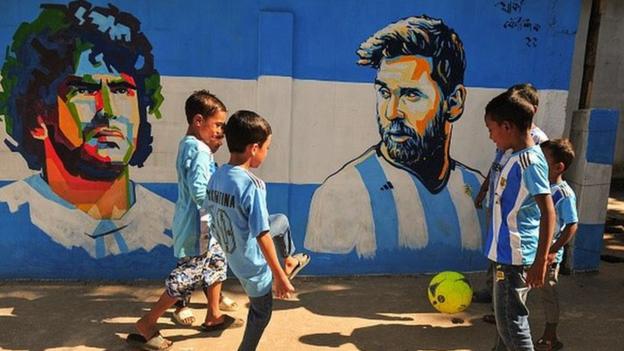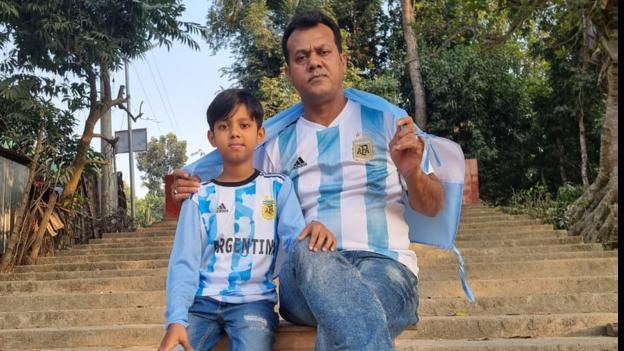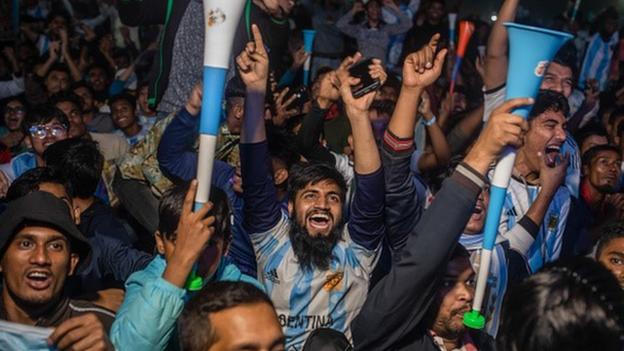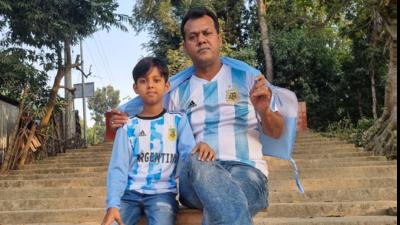
When Lionel Messi walks onto Lusail Stadium to take on France in Sunday’s World Cup final he will carry with him the hopes of a nation.
Miles away in Bangladesh, ‘Messi mania’ has taken hold – and an army of ‘superfans’ will also be right behind him.
So why is a country known for cricket and sitting between Samoa and Djibouti at the bottom of FIFA’s world rankings so passionate about Argentinian football?
Like many conversations about the beautiful game, it begins with one name – the late Diego Armando Maradona.
“When he had the ball, he played with arrogance! We watched with ecstasy,” reflects 48-year-old Mashiur Rahman, from his home in Kashiani in Southern Bangladesh.
“Maradona created such magic in one World Cup, we all are still mesmerized.”

The first World cup to be shown in colour in Bangladesh belonged to Maradona. In Mexico 1986, the twenty five year old created footballing folklore, scoring what is considered the goal of the century. He scored five times in Argentina’s second successful World Cup title run.
Just twelve years old at the time, Mashiur remembers that with no footballing success of their country’s own, his family, like many others in Bangladesh, were ready to adopt a new hero. The timing was perfect.
“Television was a big attraction in our home – we were mesmerised by Argentine football,” he says.
“My uncles are all Argentina fans. I’m one of three brothers and apart from the little one, we are all Argentina fans too.”
“The moment I got to know about football, I started supporting Argentina.”

The two countries are not connected by direct flights, and have very little in common, but football seems to be bringing them closer together.
Last week, Argentina’s foreign minister Santiago Cafiero tweeted that Buenos Aires would establish new diplomatic relations with Bangladesh.
It’s thought this is a result of the outpouring of Bangladeshi support on social media, which has spiked after each of Argentina’s wins.
It’s support which has not gone unnoticed. Argentina’s Head Coach Lionel Scaloni thanked Bangladesh in a pre-match press conference and, earlier this month, the team’s official Twitter feed posted images of thousands of fans watching in Bangladesh, saying “Thank you for supporting our team. They are crazy like us!”
These days Mashiur shares his “football heritage” and passion for the team nicknamed La Albiceleste (the white and sky blue) with his son Nafi.
But Nafi has a new hero.
If you visit Bangladesh today, it’s Lionel Messi’s face painted in murals on the streets of Dhaka and his shirt sold by market vendors. His celebrity is propelled by social media to a new generation of fans.
Messi’s supporters believe it is his destiny to win his country’s third title.
“Maradona cannot be copied because of the aura of him, but Messi is near, Messi is special,” says Mashiur.

Mashiur won’t allow himself to think of anything other than victory on Sunday for Argentina. But there’s a lot to do before the final.
Throughout the tournament, fans in Kashiani have been prepared to watch Argentina through the night, as many of the games began in the early hours.
In Dhaka, big screens will show the final to tens of thousands – Mashiur has arranged three screens for more than a thousand people to watch in his neighbourhood, as well as large servings of the popular rice dish Khichuri – a staple of any picnic in Bangladesh.
All he can do now, is wait, he says: “In Bangladesh, every fan of Argentina is sure about success in the World Cup final.”

